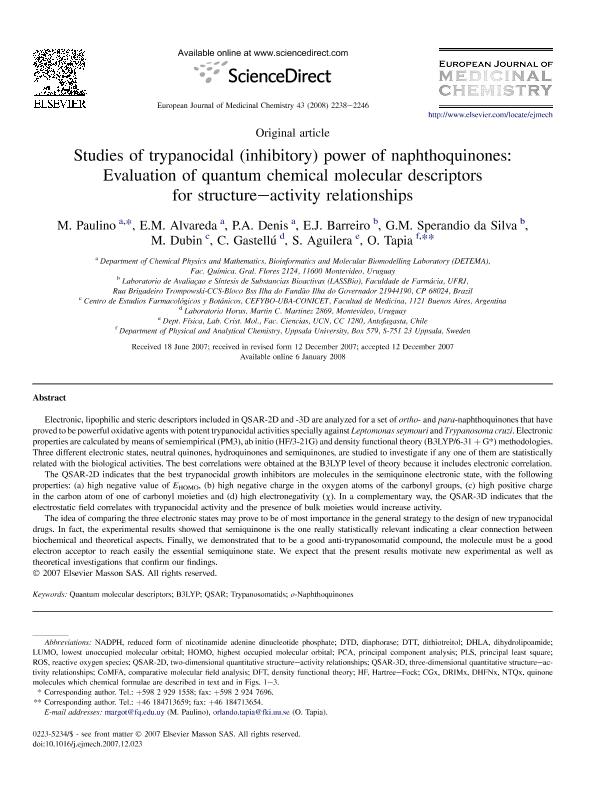Mostrar el registro sencillo del ítem
dc.contributor.author
Paulino, M.
dc.contributor.author
Alvareda, E. M.
dc.contributor.author
Denis, P. A.
dc.contributor.author
Barreiro, E. J.
dc.contributor.author
Sperandio da Silva, G. M.
dc.contributor.author
Dubin, Marta

dc.contributor.author
Castellú, C.
dc.contributor.author
Aguilera, S.
dc.contributor.author
Tapia, O.
dc.date.available
2017-07-11T21:48:31Z
dc.date.issued
2008-10
dc.identifier.citation
Paulino, M.; Alvareda, E. M.; Denis, P. A.; Barreiro, E. J.; Sperandio da Silva, G. M.; et al.; Studies of trypanocidal (inhibitory) power of naphthoquinones: evaluation of quantum chemical molecular descriptors for structure–activity relationships; Elsevier Masson; European Journal of Medical Chemistry; 43; 10; 10-2008; 2238-2246
dc.identifier.issn
0223-5234
dc.identifier.uri
http://hdl.handle.net/11336/20206
dc.description.abstract
Electronic, lipophilic and steric descriptors included in QSAR-2D and -3D are analyzed for a set of ortho- and para-naphthoquinones that have proved to be powerful oxidative agents with potent trypanocidal activities specially against Leptomonas seymouri and Trypanosoma cruzi. Electronic properties are calculated by means of semiempirical (PM3), ab initio (HF/3-21G) and density functional theory (B3LYP/6-31 + G∗) methodologies. Three different electronic states, neutral quinones, hydroquinones and semiquinones, are studied to investigate if any one of them are statistically related with the biological activities. The best correlations were obtained at the B3LYP level of theory because it includes electronic correlation. The QSAR-2D indicates that the best trypanocidal growth inhibitors are molecules in the semiquinone electronic state, with the following properties: (a) high negative value of EHOMO, (b) high negative charge in the oxygen atoms of the carbonyl groups, (c) high positive charge in the carbon atom of one of carbonyl moieties and (d) high electronegativity (χ). In a complementary way, the QSAR-3D indicates that the electrostatic field correlates with trypanocidal activity and the presence of bulk moieties would increase activity. The idea of comparing the three electronic states may prove to be of most importance in the general strategy to the design of new trypanocidal drugs. In fact, the experimental results showed that semiquinone is the one really statistically relevant indicating a clear connection between biochemical and theoretical aspects. Finally, we demonstrated that to be a good anti-trypanosomatid compound, the molecule must be a good electron acceptor to reach easily the essential semiquinone state. We expect that the present results motivate new experimental as well as theoretical investigations that confirm our findings.
dc.format
application/pdf
dc.language.iso
eng
dc.publisher
Elsevier Masson

dc.rights
info:eu-repo/semantics/openAccess
dc.rights.uri
https://creativecommons.org/licenses/by-nc-sa/2.5/ar/
dc.subject
Quantum Molecular Descriptors
dc.subject
B3lyp
dc.subject
Qsar
dc.subject
Trypanosomatids
dc.subject
O-Naphthoquinones
dc.subject.classification
Biología Celular, Microbiología

dc.subject.classification
Ciencias Biológicas

dc.subject.classification
CIENCIAS NATURALES Y EXACTAS

dc.title
Studies of trypanocidal (inhibitory) power of naphthoquinones: evaluation of quantum chemical molecular descriptors for structure–activity relationships
dc.type
info:eu-repo/semantics/article
dc.type
info:ar-repo/semantics/artículo
dc.type
info:eu-repo/semantics/publishedVersion
dc.date.updated
2017-07-11T19:46:30Z
dc.journal.volume
43
dc.journal.number
10
dc.journal.pagination
2238-2246
dc.journal.pais
Francia

dc.journal.ciudad
París
dc.description.fil
Fil: Paulino, M.. Bioinformatics and Molecular Biomodelling Laboratory ; Uruguay
dc.description.fil
Fil: Alvareda, E. M.. Bioinformatics and Molecular Biomodelling Laboratory ; Uruguay
dc.description.fil
Fil: Denis, P. A.. Bioinformatics and Molecular Biomodelling Laboratory ; Uruguay
dc.description.fil
Fil: Barreiro, E. J.. Universidade Federal do Rio de Janeiro; Brasil
dc.description.fil
Fil: Sperandio da Silva, G. M.. Universidade Federal do Rio de Janeiro; Brasil
dc.description.fil
Fil: Dubin, Marta. Consejo Nacional de Investigaciones Científicas y Técnicas. Oficina de Coordinación Administrativa Houssay. Centro de Estudios Farmacológicos y Botánicos. Universidad de Buenos Aires. Facultad de Medicina. Centro de Estudios Farmacológicos y Botánicos; Argentina
dc.description.fil
Fil: Castellú, C.. Laboratorio Horus; Uruguay
dc.description.fil
Fil: Aguilera, S.. Universidad Católica de Chile; Chile
dc.description.fil
Fil: Tapia, O.. Uppsala University. Department of Physical and Analytical Chemistry; Suecia
dc.journal.title
European Journal of Medical Chemistry

dc.relation.alternativeid
info:eu-repo/semantics/altIdentifier/url/http://www.sciencedirect.com/science/article/pii/S0223523407004886
dc.relation.alternativeid
info:eu-repo/semantics/altIdentifier/doi/http://dx.doi.org/10.1016/j.ejmech.2007.12.023
Archivos asociados
